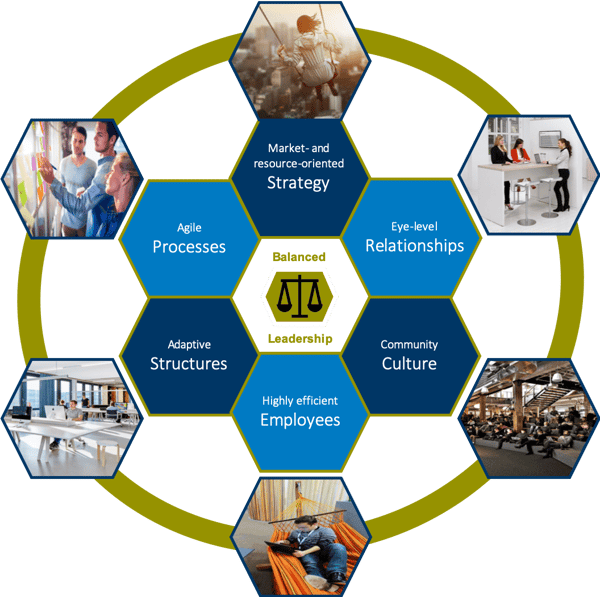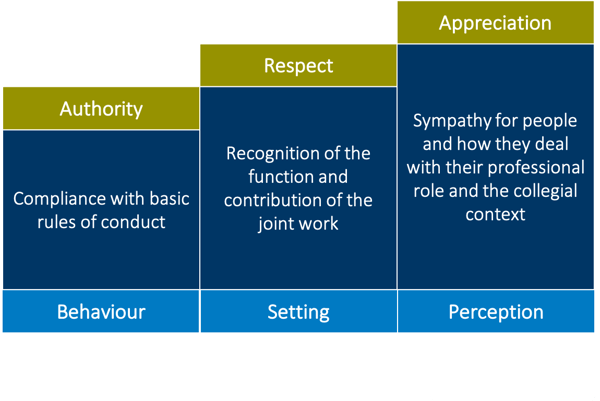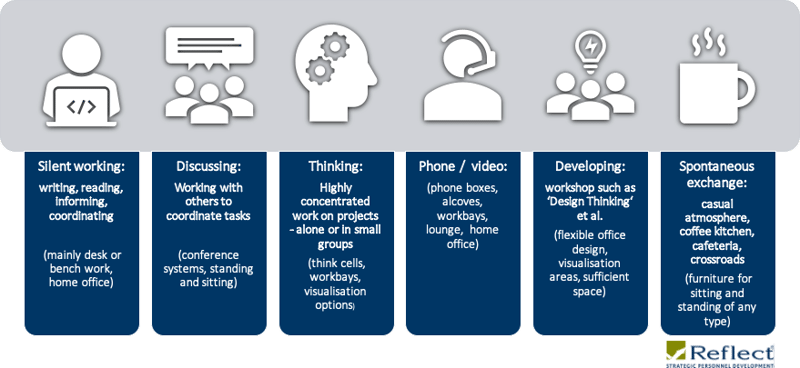New working worlds - the essentials
We have dedicated ourselves to the transformation of Industry 3.0 towards a "New Work" organization with the series "New Working Worlds 1-8" and have paid particular attention here to space. In this note, we summarize the "Essentials" of this series for you with the trend topic "Workplace Change".
As our society finds itself in constant flux, the workplace is forced to adapt to these changes. To put a positive spin on it: Encrusted structures are breaking down and creating space for new thinking, action and potential development.
The most relevant insights from the series:

Figure 1: Model of the Healthy Organization (Kallenbach, 2016)
Balanced leadership and space
In our Balanced Leadership concept, leadership takes place on three levels. Leaders lead themselves, take responsibility for others in the team, and also lead the overall organization. Leadership tasks are thus distributed among different people and are no longer dependent on individuals.
Employees should find themselves within the organizational structures and be able to help shape and change them. Self-organization is one of the decisive aspects.
There should be quiet zones for concentrated work, coffee and comfortable reading corners for recreation during breaks, standing desks and other ergonomic offerings bring movement into everyday office life, and a fitness room creates the opportunity to stay healthy and fit - despite predominantly sedentary work.
This is where managers can lead the way and balance the various demands of private and working life.
Managers would do well to work with their teams to create a work context in which potential can be developed. The direction is clear: more self-organization, more cross-functional teams, more multi-territorial workplaces.
At the corporate level, the aim is to design overall organizational structures that are adaptable, organic and customer centric. Buildings can be planned and constructed according to their value chain from the customer's point of view.
The people who are responsible for part of this value chain ("end-to-end") are located in the immediate vicinity. In the best case, this creates an organic flow that provides meaning and orientation.
Relationships at eye level and space
Flexible working hours, agile workplaces and home office options are increasingly important criteria in the "war for talent". Respect, esteem and appreciation take a high priority in the "New Work" generations.
Internally, eye-level relationships are formed through cooperation, mutual trust and support, commitment and positive presentation of the company.
 Figure 2: Eye-level relationships in the Healthy Organization (Kallenbach, 2016).
Figure 2: Eye-level relationships in the Healthy Organization (Kallenbach, 2016).
The work environment has a significant impact on the extent to which relationships - and thus the way of working in a company - can succeed. Specifically, consider whether employees in your organization are treated unequally because of where they work.
- Managers sit (or stand) with their team, interaction is at eye level and characterized by respect and appreciation.
- The choice of workplace (window, corner room, in front of the door/WC/corridor) is fair and benefit-oriented. The status of the position is not apparent from the workplace. In case of doubt, the employees* rotate in a certain rhythm to balance advantages and disadvantages of workplaces.
- The "home office" workplace should also be designed in such a way that healthy and permanently efficient work is possible. The legal clause of "mobile working" accepted by most in Corona crisis times, which made it possible to equip employees* only with a laptop for the "home office", is over. In the future, viable solutions will be needed that allow home and office work to coexist.
Community culture and space
Corporate culture is the result of mutual interdependencies of the dimensions of a Healthy Organization. Strategies, processes - not least the structure of an organization - have an impact on culture. It is the result of these mutually influencing dimensions.
Culture cannot be managed - it cannot be controlled like a trivial machine. It is the result of a complex process within a social system called an organization, company, firm or business.
When the space changes, the relationships within it also change and the opportunity for relationships and culture arises. Space should therefore reflect the meaning, values and products of the organization through deliberate artistic design.
This kind of spatial art - brought forth by installations, graphics or paintings - not only feeds the soul of the person, but also has a positive effect on the creation of identity in the company.
Adaptive structures and space
In relation to space, structures form the blueprint, the architecture of an organization, as it were.
Adaptive structures are characterized by a high degree of (self-)adaptability. Through their design, they allow for customer-oriented thinking, feeling and acting, speed and smart decisions by employees as well as the development of existing potentials in co-creative processes.
One of the most important tasks is therefore to create an environment in which employees can fully develop their potential. Depending on the area of responsibility and the job, these requirements and the associated working modes diverge.
Spaces - including "home office" - should accommodate these different work modes as much as possible to enable healthy and effective work. In the following illustration, we have compared the work modes that are most relevant in our view with corresponding room concepts.

Figure 3: Working modes - Multispace Office
Hybrid processes and space
Hybrid processes distinguish between controllable-mechanical and living-dynamic environmental conditions. They include the possibility of continuous adaptation to the respective context.
The more complex the environment, the more agile the processes - the more linear the framework conditions, the more suitable are mechanical-controllable procedures. Hybrid processes therefore form a suitable response to a wide variety of contextual conditions.
The "layouts" of the rooms offer a high degree of flexibility through mobile furniture, adjustable walls and separation options. As a result, working systems can also be visually represented as required, enabling agile working (Scrum, Kanban, etc.).
Market and resource-oriented strategy and the space
The strategic direction of a company can be greatly supported by the environment. Especially the coming generations attach a lot of importance to lived sustainability.
In order to attract and retain employees, the "community" factor is becoming increasingly important, and with it the question of how buildings and space can make a visible contribution to an overall sustainable strategy.
Therefore, rethinking is called for.
The authenticity of the company's long-term orientation is crucial for success. "Green washing" inevitably leads to image damage sooner or later.
Authenticity can always be achieved when the responsible decision-makers are serious, even if short-term EBIT losses are to be feared. This creates a culture that significantly supports the strategy and does not corrupt it.
This holistic approach is completed in the choice of materials for the building, the efficiency of the selected infrastructure, and the creation of a healthy indoor climate (see figure below).
Conclusion:
The quality of the environment and the quality of interaction are key drivers for employees. The infrastructure of today's offices still mostly lags behind the requirements of these needs. The importance of space and the quality of interaction have a significant influence on employee motivation and on all other dimensions of a healthy organization.
Companies would therefore do well to become aware of this connection, to redesign working environments and to make investments in order to offer their employees prosperous conditions in which retention and growth are possible. It is the motivated and efficient employees who enable long-term competitiveness.
REFLECT helps you to align your company for the future. Together with you, we develop an individually tailored, holistic transformation process towards a healthy organization. Our claim: We would like to position you not only competitively, but as a market leader for the working world 4.0. Feel free to contact us!
Blog post image source:
Copyright: Otto Kasper
Recommended reading:
New working environments (part 8) - room and strategy
New working environments (part 7) - room and hybrid processes
New working environments (part 6) - room and adaptive structures
New working environments (part 5) - room and company culture
New working environments (part 4) - room and eye-level relationships
New working environments (part 3) - room and leadership 4.0

